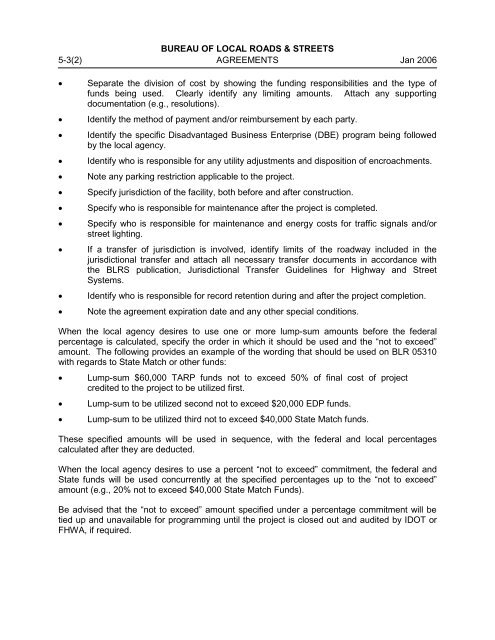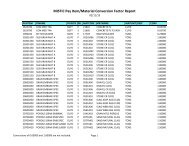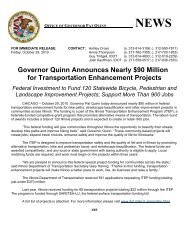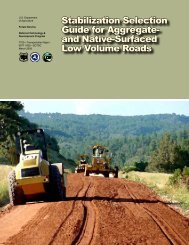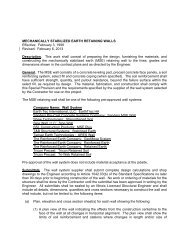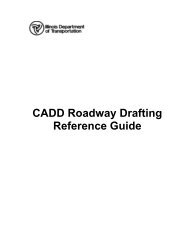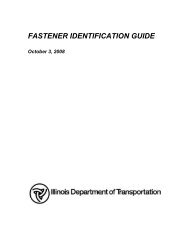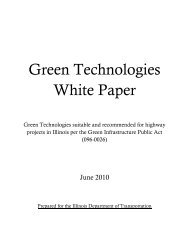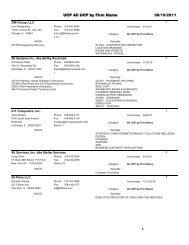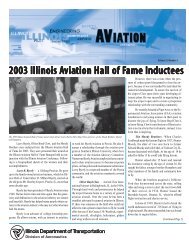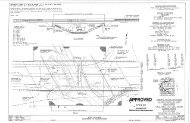Chapter Five AGREEMENTS - Illinois Department of Transportation
Chapter Five AGREEMENTS - Illinois Department of Transportation
Chapter Five AGREEMENTS - Illinois Department of Transportation
Create successful ePaper yourself
Turn your PDF publications into a flip-book with our unique Google optimized e-Paper software.
BUREAU OF LOCAL ROADS & STREETS<br />
5-3(2) <strong>AGREEMENTS</strong> Jan 2006<br />
• Separate the division <strong>of</strong> cost by showing the funding responsibilities and the type <strong>of</strong><br />
funds being used. Clearly identify any limiting amounts. Attach any supporting<br />
documentation (e.g., resolutions).<br />
• Identify the method <strong>of</strong> payment and/or reimbursement by each party.<br />
• Identify the specific Disadvantaged Business Enterprise (DBE) program being followed<br />
by the local agency.<br />
• Identify who is responsible for any utility adjustments and disposition <strong>of</strong> encroachments.<br />
• Note any parking restriction applicable to the project.<br />
• Specify jurisdiction <strong>of</strong> the facility, both before and after construction.<br />
• Specify who is responsible for maintenance after the project is completed.<br />
• Specify who is responsible for maintenance and energy costs for traffic signals and/or<br />
street lighting.<br />
• If a transfer <strong>of</strong> jurisdiction is involved, identify limits <strong>of</strong> the roadway included in the<br />
jurisdictional transfer and attach all necessary transfer documents in accordance with<br />
the BLRS publication, Jurisdictional Transfer Guidelines for Highway and Street<br />
Systems.<br />
• Identify who is responsible for record retention during and after the project completion.<br />
• Note the agreement expiration date and any other special conditions.<br />
When the local agency desires to use one or more lump-sum amounts before the federal<br />
percentage is calculated, specify the order in which it should be used and the “not to exceed”<br />
amount. The following provides an example <strong>of</strong> the wording that should be used on BLR 05310<br />
with regards to State Match or other funds:<br />
• Lump-sum $60,000 TARP funds not to exceed 50% <strong>of</strong> final cost <strong>of</strong> project<br />
credited to the project to be utilized first.<br />
• Lump-sum to be utilized second not to exceed $20,000 EDP funds.<br />
• Lump-sum to be utilized third not to exceed $40,000 State Match funds.<br />
These specified amounts will be used in sequence, with the federal and local percentages<br />
calculated after they are deducted.<br />
When the local agency desires to use a percent “not to exceed” commitment, the federal and<br />
State funds will be used concurrently at the specified percentages up to the “not to exceed”<br />
amount (e.g., 20% not to exceed $40,000 State Match Funds).<br />
Be advised that the “not to exceed” amount specified under a percentage commitment will be<br />
tied up and unavailable for programming until the project is closed out and audited by IDOT or<br />
FHWA, if required.


